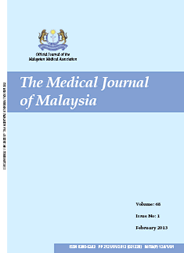MJM, Vol 70 Supplement 1 September 2015
Efficacy of SMS and telephone call reminders on
adherence and treatment outcomes among HIV positive patients on Antiretroviral
Therapy (ART) in Malaysia: a Randomised Controlled Trial (RCT)
*Department of Community Health, Faculty of Medicine and Health Sciences, Universiti Putra Malaysia, Serdang, Malaysia, **Hospital Sungai Buloh, Malaysia, ***Department of Paediatrics, Faculty of Medicine and Health Sciences, UPM, Universiti Putra Malaysia, Serdang, Malaysia
ABSTRACT
Introduction: Adherence to treatment remains the cornerstone of successful treatment outcomes among patients receiving ART. The objective of this study was to determine the effectiveness of mobile phone technology (SMS and telephone call reminders) in improving adherence and treatment outcomes among HIV positive patients on ART in Malaysia.
Methods: This single-blind, parallel group RCT was conducted in Hospital Sungai Buloh among 242 HIV positive patients who initiated ART. They were followed up for 6 months, between January and December 2014. Eligible patients that met inclusion criteria were randomised to treatment and control arms (1:1) with allocation concealment. Data on socio-demographic factors, clinical symptoms, and adherence behaviour, assessed using the modified and validated Adult AIDS Clinic Trials Group adherence questionnaires, were collected. CD4 count, viral load, weight, and full blood counts were also recorded. Intervention included a “Reminder module” delivered continuously for 6 months in addition to standard care. Multivariate regression models were used to evaluate efficacy of the intervention, using SPSS version 21 and R software.
Results: Majority (93%) completed 6-month follow up. Mean age was 33.4 (standard deviation (SD) 9.2) years. Majority (88.8%) were males. There was no statistically significant difference in gender, income and employment distributions between the intervention and control group. Mean adherence increased from 80.1% (SD 19.8) and 85.1% (SD 15.8) to 95.7% (SD 1.6) and 87.5% (SD 9.9) in the intervention and control groups respectively at the end of 6 months (p=0.035). A higher frequency in missed appointments (p=0.001), higher viral load (p=0.001), lower rise in CD4 count (p=0.017), and higher incidence of tuberculosis (p=0.001) at 6 months was observed among the control group.
Conclusion: This study provides further evidence to support the WHO recommendation of the use of SMS as a reminder tool and to keep patients engaged, thereby promoting their adherence to ART.
Keywords: Adherence, Mobile phone technology, Antiretroviral Therapy (ART), Antiretroviral medications (ARVs), HIV/AIDS, CD4 count, Viral load, treatment outcomes.
